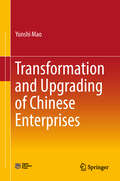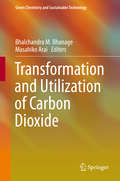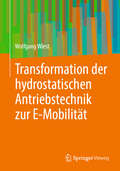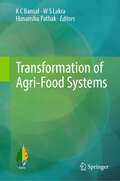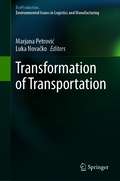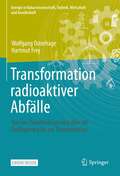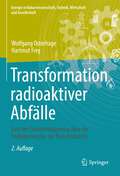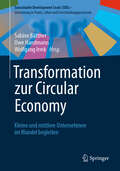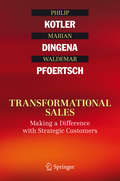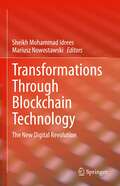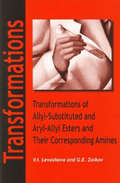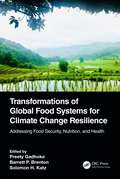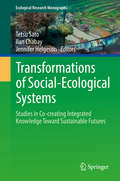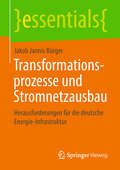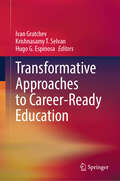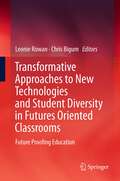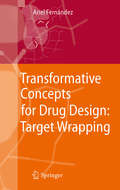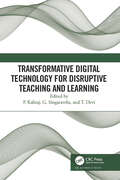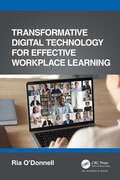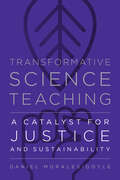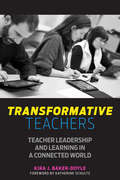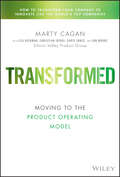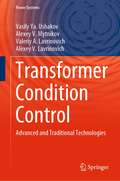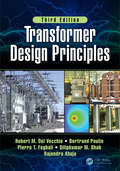- Table View
- List View
Transformation and Upgrading of Chinese Enterprises
by Yunshi MaoThis book discusses the experience of enterprise transformation and upgrading and the role of government in promoting this dramatic change in Asian emerging economies. The author specifically explores the direction, influencing factors, paths and modes of enterprise transformation and upgrading by conducting intensive case studies on a number of enterprises having accomplished upgrading in mainland China and Taiwan, and draws experience and lessons from them. These theoretical and practical insights have great significance for Chinese enterprises in improving their ability to respond to drastic external changes and provide useful reference for the formulation of government policies.
Transformation and Utilization of Carbon Dioxide
by Bhalchandra M. Bhanage Masahiko AraiTransformation and Utilization of Carbon Dioxide shows the various organic, polymeric and inorganic compounds which result from the transformation of carbon dioxide through chemical, photocatalytic, electrochemical, inorganic and biological processes. The book consists of twelve chapters demonstrating interesting examples of these reactions, depending on the types of reaction and catalyst. It also includes two chapters dealing with the utilization of carbon dioxide as a reaction promoter and presents a wide range of examples of chemistry and chemical engineering with carbon dioxide. Transformation and Utilization of Carbon Dioxide is a collective work of reviews illustrative of recent advances in the transformation and utilization of carbon dioxide. This book is interesting and useful to a wide readership in the various fields of chemical science and engineering. Bhalchandra Bhanage is a professor of industrial and engineering chemistry at Institute of Chemical Technology, India. Masahiko Arai is a professor of chemical engineering at Hokkaido University, Japan.
Transformation der hydrostatischen Antriebstechnik zur E-Mobilität
by Wolfgang WiestDieses Lehr- und Fachbuch dient als Leitfaden für die Transformation zur Projektierung von E-Mobilitätssystemen als Substitution von hydrostatischen Antriebssystemen im Kontext der E-Mobilität. Es zeigt auf, welche Rahmenbedingungen bei der Transformation vorhanden sein und beachtet werden müssen und welche zusätzlichen technischen Potentiale im Vergleich zu den bisherigen hydraulischen Antriebsstrukturen nutzbar sind. Da zukünftig beide Systeme erforderlich sind, kommt einer Plattformstruktur besondere Bedeutung zu. In diesem Buch werden entsprechende Optionen dargestellt und erläutert. Zielgruppe sind Studierende an den Technischen Hochschulen und Universitäten aber auch Mitarbeitende in Konstruktions- und Entwicklungsabteilungen der Fahrzeugindustrie.
Transformation of Agri-Food Systems
by Himanshu Pathak K. C. Bansal W. S. LakraThis edited volume covers all major topics related to agri-food transformation towards sustainability in this era of climate change. The topics cover field crops, horticultural crops, livestock sector, nutritional aspects, application of latest field-based technologies, and agriculture related policies and institutions.Some of the key topics are: Innovations for Reconfiguring Food Systems; Transforming High-value Food Commodities; Demand-Supply of Agri-food Commodities; Balancing Human Demand and Ecological Sustainability; International Partnership for Transformation of Agri-Food Systems; Transforming Animal Health and Aquatic Food Systems for Food Security; Climate Resilient Agriculture; Addressing Nutritional Security through Natural Resource Management; Water Harvesting and Improving Water Productivity; Combating Micronutrient Deficiencies; Plant Genetic Resources for Food Security and Nutrition; Genome Editing for Crop Improvement; and Biosafety and Socioeconomic Considerations.Written by experts, this book serves in exchanging and sharing the latest research findings, ideas and experiences on all aspects of agri-food systems to enable the formulation of the ways forward to transform our agri-food system to meet the Sustainable Development Goals (SDGs) of the United Nations by 2030. The target audience include academicians, researchers, students, farmers, entrepreneurs, policy makers, and others.
Transformation of Transportation (EcoProduction)
by Marjana Petrović Luka NovačkoThis book features original scientific manuscripts submitted for publication at the International Conference – The Science and Development of Transport (ZIRP 2020), organized by University of Zagreb, Faculty of Transport and Traffic Sciences, Zagreb, and held in Šibenik, Croatia, from 29th to 30th September 2020. The conference brought together scientists and practitioners to share innovative solutions available to everyone. Presenting the latest scientific research, case studies and best practices in the fields of transport and logistics, the book covers topics such as sustainable urban mobility and logistics, safety and policy, data science, process automation, and inventory forecasting, improving competitiveness in the transport and logistics services market and increasing customer satisfaction. The book is of interest to experienced researchers and professionals as well as Ph.D. students in the fields of transport and logistics.
Transformation radioaktiver Abfälle: Von der Zwischenlagerung über die Endlagerung bis zur Transmutation (Energie in Naturwissenschaft, Technik, Wirtschaft und Gesellschaft)
by Wolfgang Osterhage Hartmut FreyDieses Buch gibt einen Überblick über den Umgang mit radioaktiven Reststoffen. Es zeigt auf, welche Quellen für radioaktive Abfälle es gibt, wie die Optionen Zwischenlagerung und Endlagerung gestalte sind, sowie, welche Problem sich aus dem Transport radioaktiver Stoffe ergeben. Schließlich beschreibt es noch die Möglichkeit der Transmutation - also die Elementumwandlung durch gezielte Kernreaktionen - und eine dazugehörige Anwendung.
Transformation radioaktiver Abfälle: Von der Zwischenlagerung über die Endlagerung bis zur Transmutation (Energie in Naturwissenschaft, Technik, Wirtschaft und Gesellschaft)
by Wolfgang Osterhage Hartmut FreyDieses Buch gibt einen Überblick über den Umgang mit radioaktiven Reststoffen. Es zeigt auf, welche Quellen für radioaktive Abfälle es gibt, wie die Optionen Zwischenlagerung und Endlagerung gestalte sind, sowie, welche Problem sich aus dem Transport radioaktiver Stoffe ergeben. Schließlich beschreibt es noch die Möglichkeit der Transmutation - also die Elementumwandlung durch gezielte Kernreaktionen - und eine dazugehörige Anwendung.
Transformation zur Circular Economy: Kleine und mittlere Unternehmen im Wandel begleiten (Sustainable Development Goals (SDG) – Umsetzung in Praxis, Lehre und Entscheidungsprozessen)
by Sabine Büttner Uwe Handmann Wolfgang IrrekIn den Beiträgen dieses Buches werden Herangehensweisen, Werkzeuge und Erfolgsfaktoren für die Sensibilisierung und den Wissenstransfer ebenso wie technische Verfahren und Good-Practice-Beispiele vorgestellt, wie sie im Projekt „Prosperkolleg – Transformationsforschung zur zirkulären Wertschöpfung“ entwickelt und exemplarisch in der Region Emscher-Lippe und darüber hinaus in NRW erprobt werden konnten. Flankiert werden diese umsetzungsbezogenen Darstellungen durch Hintergründe zum Konzept der Circular Economy und ihrer Potentiale sowie Trends der wissenschaftlichen Forschung und die Reflexion weiterer Transformationsperspektiven.
Transformational Sales: Making a Difference with Strategic Customers
by Philip Kotler Waldemar Pfoertsch Marian DingenaInspired by a new, transformative era in human and business relations, this book provides a unique perspective on the business transformation that results from the collaboration between suppliers and their strategic customers. It is all about guiding organizational change and business transformation, starting with sales itself. Companies choosing this approach can make a significant and meaningful difference with strategic customers, moving beyond the competition. By challenging existing business assumptions and creating new perspectives on the marketplace, organizations can increase value across traditional company borders, making the (business) world a better place in the process. Both thought-provoking and practical, this management book integrates academic insights, real life examples and best practices of business transformation. It is a must-read for business leaders aiming to make a difference."Integrating with your strategic customers beyond a transactional sales relationship is key for shaping new markets, developing your brand, and leveraging your strategic relationships. If sales and profitability with strategic accounts are to grow beyond the average, a change in mindset from seeing sales as an “outside” to an “inside” job is required to truly create a win-win relationship. Kotler/Dingena/Pfoertsch’s “Transformational Sales” provides hands-on insights and tools needed for companies who truly want to achieve this transformation." Marc Hantscher, CEO and President Asia-Pacific, BSH Home Appliances Pte. Ltd. Singapore"The more profoundly and systematically B2B companies familiarize themselves with and accommodate their customers’ functional, emotional and strategic needs, the more powerful they are on the market. Top brands are professionally and passionately tuned in to their customers. Sales, Project Management, Marketing, R&D, Production and Purchasing work in concert to drive customer success, always with an eye to the future. This book presents illustrative cases, highlighting how champions have scaled up their business." Achim Kuehn, CMO Herrenknecht AG, Schwanau, Germany
Transformations Through Blockchain Technology: The New Digital Revolution
by Sheikh Mohammad Idrees Mariusz NowostawskiThe book serves as a connecting medium between various domains and Blockchain technology, discussing and embracing how Blockchain technology is transforming all the major sectors of the society. The book facilitates sharing of information, case studies, theoretical and practical knowledge required for Blockchain transformations in various sectors. The book covers different areas that provide the foundational knowledge and comprehensive information about the transformations by Blockchain technology in the fields of business, healthcare, finance, education, supply-chain, sustainability and governance. The book pertains to students, academics, researchers, professionals, and policy makers working in the area of Blockchain technology and related fields.
Transformations of Allyl-Substituted and Aryl-Allyl Esters and Their Corresponding Amines
by Gennady Zaikov LevashovaThe book generally shows the interrelation between allyl unit structure of the initial ester and composition and structure of its products. The first part studies the pathways of chemical regrouping in chlorallylaryl and bisarylallyl esters using quantum-chemical calculations. Energy parameters, structural features and electron structure of interme
Transformations of Global Food Systems for Climate Change Resilience: Addressing Food Security, Nutrition, and Health
by Solomon H. Katz Preety Gadhoke Barrett P. BrentonTransformations of Global Food Systems for Climate Change Resilience: Addressing Food Security, Nutrition, and Health provides poignant case studies of climate change resilience frameworks for nutrition-focused transformations of agriculture and food systems, food security, food sovereignty, and population health of underserved and marginalized communities from across the globe. Each chapter is drawn from diverse cultural contexts and geographic areas, addressing local challenges of ongoing food and health system transformations and illustrating forms of resistance, resilience, and adaptations of food systems to climate change. Fourteen chapters present global case studies, which directly address the United Nations Sustainable Development Goals and the Food and Agriculture Organization’s global call to action for transforming agriculture, addressing food security and nutrition, and the health of populations impacted by climate change and public health issues.They also integrate reflections, insights, and experiences resulting from the COVID-19 Pandemic. This edited volume includes research on (1) enhancing food sovereignty and food security for underserved populations with a particular focus on indigenous peoples; (2) improving locally contextualized definitions and measurements of climate change resilience, food security, hunger, nutrition, and health; (3) informing public health programs and policies for population health and nutrition; and (4) facilitating public and policy discourse on sustainable futures for community health and nutrition in the face of climate change and natural disasters, including ongoing and future pandemics or emergencies. Within this book, readers discover an array of approaches by the authors that exemplify the mutually engaged and reciprocal partnerships that are community-driven and support the positive transformation of the people with whom they work. By doing so, this book informs and drives a global sustainable future of scholarship and policy that is tied to the intersectionality and synergisms of climate change resilience, food security, food sovereignty, nutrition, and community health.
Transformations of Social-Ecological Systems: Studies in Co-creating Integrated Knowledge Toward Sustainable Futures (Ecological Research Monographs)
by Tetsu Sato Ilan Chabay Jennifer HelgesonThrough this book, readers will gain a comprehensive overview of transdisciplinary knowledge co-production in local contexts as an issue-driven and solution-oriented process, and will come to understand its relationship to societal transformation processes toward sustainability. In a single volume, the theory, approaches and academic implications of this novel type of knowledge production are addressed, together with its societal impacts.In the midst of global anthropogenic impacts that affect various environments, over the past few decades we have observed autonomous initiatives in local communities around the world to tackle these environmental challenges. It is vital that such local actions be scaled up to achieve sustainable societies, which requires societal transformation on larger scales. Thanks to numerous collaborative actions in local communities, transdisciplinary knowledge co-production among diverse stakeholders has successfully been mobilized, resulting in the development of Integrated Local Environmental Knowledge (ILEK); knowledge that can inform and support decisions and actions promoting the sustainable transformation of society. This book uses comparative case studies in communities around the world to illuminate and clarify processes and factors promoting the co-production and utilization of ILEK to facilitate decision-making. In addition, readers will gain deeper insights into the science-society interactions that can contribute to finding collaborative solutions to a wide range of critical environmental problems. Though the book is ideally suited for researchers and students, it also offers a valuable resource for practitioners, government agencies, and stakeholder agencies.
Transformationsprozesse und Stromnetzausbau: Herausforderungen für die deutsche Energie-Infrastruktur (essentials)
by Jakob Jannis BürgerJakob Jannis Bürger zeigt prägnant, wie der deutsche Stromnetzausbau geplant und umgesetzt wird. Neben der Energiewende stellen auch versäumte Modernisierungen und veränderte Marktstrukturen die Stromnetze vor beachtliche Herausforderungen. Deshalb wurden von Politik, Regulierungsbehörden und Netzbetreibern Ausbaupläne erstellt und entsprechende Maßnahmen eingeleitet. Dennoch ist ungewiss, wie schnell die jeweiligen Projekte umgesetzt werden können. Zur Orientierung liefert dieses Buch daher einen Überblick über die bisherige Entwicklung des Netzausbaus sowie der politischen Netzausbauplanung in Deutschland.
Transformative Approaches to Career-Ready Education
by Ivan Gratchev Krishnasamy T. Selvan Hugo G. EspinosaUniversities worldwide play a pivotal role in shaping the future workforce by equipping students with the skills, knowledge, and attitude required to thrive in an ever-evolving job market. Transformative Approaches to Career-Ready Education addresses the critical challenge of aligning higher education with modern industry and national expectations. This book brings together diverse perspectives from leading educators, researchers, and industry practitioners, offering practical strategies to enhance teaching and learning. Inspired by the Webinars in Engineering Education initiative, a collaboration between Griffith University, Australia, and SSN College of Engineering, India, this book explores innovative pedagogies, immersive learning environments, higher education goals, and assessment practices that foster critical thinking, problem-solving, and adaptability among students. Organized into four thematic sections, the chapters delve into foundational skills for career success, practical approaches to career readiness, industry insights on graduate employability, and transformative innovations for higher education. Featuring case studies, evidence-based practices, and future-oriented discussions, this book showcases how universities can empower students to meet the demands of a rapidly evolving world. Ideal for educators, policymakers, and industry leaders, this book inspires a reimagining of higher education to produce career-ready graduates who are not only prepared to enter the workforce but to excel and grow throughout their professional journeys.
Transformative Approaches to New Technologies and Student Diversity in Futures Oriented Classrooms
by Leonie Rowan Chris BigumIn this book we outline an optimistic, aspirational and unashamedly ambitious agenda for schooling. We make cautious use of the concept of 'future proofing' to signal the commitment of the various authors to re-thinking the purposes, content and processes of schooling with a view to ensuring that all children, from all backgrounds are prepared by their education to make a positive contribution to the futures that are ahead of them. The book focuses on issues relating to technology and social justice to re-examine the traditional relationship between schools and technology, between schools and diverse learners, and between schools, children and knowledge. Drawing from examples from around the world, the book explores practical ways that diverse schools have worked to celebrate diverse understandings of what it means to be a learner, a citizen, a worker in these changed and changing times and the ways different technologies can support this agenda.
Transformative Concepts for Drug Design: Target Wrapping
by Ariel FernandezIn spite of the enticing promises of the post-genomic era, the pharmaceutical world is in a state of disarray. Drug discovery seems now riskier and more uncertain than ever. Thus, projects get routinely terminated in mid-stage clinical trials, new targets are getting harder to find, and successful therapeutic agents are often recalled as unanticipated side effects are discovered. Exploiting the huge output of genomic studies to make safer drugs has proven to be much more difficult than anticipated. More than ever, the lead in the pharmaceutical industry depends on the ability to harness innovative research, and this type of innovation can only come from one source: fundamental knowledge. This book squarely addresses this crucial problem since it introduces fundamental discoveries in basic biomolecular research that hold potential to broaden the technological base of the pharmaceutical industry. The book takes a fresh and fundamental look at the problem of how to design an effective drug with controlled specificity. Since the novel transformative concepts are unfamiliar to most practitioners, the first part of this book explains matters very carefully starting from a fairly elementary physico-chemical level. The second part of the book is devoted to practical applications, aiming at nothing less than a paradigm shift in drug design. This book is addressed to scientists working at the cutting edge of research in the pharmaceutical industry, but the material is at the same time accessible to senior undergraduates or graduate students interested in drug discovery and molecular design.
Transformative Digital Technology for Disruptive Teaching and Learning
by P. Kaliraj T. Devi G. SingaraveluGeneration Z students are avid gamers and are always on social media. Smart like their phones, they must be educated in a smart manner, which involves the use of digital tools. Transformative Digital Technology for Disruptive Teaching and Learning provides smart education solutions and details ways in which Gen Z learners can be educated. It covers such digital learning strategies as blended learning, flipped learning, mobile learning, and gamification. It examines creative teaching–learning strategies to encourage modern learners to learn more quickly. The book discusses ways to accelerate the capabilities of teaching and learning transactions. It also covers innovative teaching and learning processes to meet the challenges of digital learners.Starting with an overview of digital learning resources and processes as well as their advantages and disadvantages, the book then discusses such approaches and strategies as follows: Learner-oriented and learner-friendly approaches Blended learning Active learning Experiential learning Virtual learning Applications of Cloud Computing and Artificial Intelligence Gamification LMS challenges and techno-pedagogical issues for modern life As digital technology is disrupting teaching and learning, especially the skill development of students in the era of Industry 4.0 and 5.0, this is a timely book. It provides methods, approaches, strategies, and techniques for innovative learning and teaching. It discusses how to leverage new technology to enhance educators’ and learners’ abilities and performance. A comprehensive reference guide for educational researchers and technology developers, the book also helps educators embrace the digital transformation of teaching and learning.
Transformative Digital Technology for Effective Workplace Learning
by Ria O'DonnellIn a world bursting with new information, ideas, opportunities, and technological advancements, it is time to rethink how continuous learning shapes our future. Amidst the ongoing digital revolution, widespread educational reform, and the most significant global pandemic of our lifetimes, we are at a pivotal time in history. Transformative Digital Technology for Effective Workplace Learning explores the technological developments that are rapidly unfolding in the workplace and those that support workplace training. What emerges is that the rate of change and the possibilities for improvement are more extensive than many of us might have suspected. From artificial intelligence to virtual reality, from data analytics, to adaptive learning, there is the capacity for significant innovation and opportunity if harnessed in the right ways. The book offers an overview of several critical issues that face the future of the workplace and examines them through the lens of lifelong learning. The book begins by conveying the current impacts on the workplace and how the internal function of Learning and Development has evolved. It then considers the eight learning imperatives that drive workplace learning and then looks at the future workplace. Exploring technological frameworks for digitally enhanced workplace learning, the book takes a deep dive into the capabilities of immersive technologies, as well as into the insights enabled through learning analytics. The goal of this book is not to merely describe technological advancements in the workplace but instead, to challenge the status quo and think critically about the future that lies ahead. One aim is to have business leaders understand the necessity for ongoing workplace learning. Another is that individuals appreciate that lifelong learning is the new social norm. Ongoing education allows people to become more open to change and less anxious about new experiences. Developing a growth mindset and adopting a company culture that says everyone can learn new things and continue to improve their performance will become the standard. Most importantly, as the business world is reconfigured before our very eyes, ongoing learning must become an economic imperative.
Transformative Propaganda: Opening the Archives of the British Safety Council
by Mike EsbesterWhat do seat belts, life jackets and anti-jack knife technology have in common? They were all the subjects of campaigns run by the British Safety Council since its inception in 1957. James Tye, its charismatic founder and leader for nearly 40 years, created the British Safety Council to bring about a transformation in how Great Britain viewed safety and health. In 1957, hundreds, if not thousands, of workers were killed in accidents and James marshalled every conceivable technique to save lives, including PR stunts, training, lobbying for better laws and, crucially, what he called ‘propaganda’, in the form of posters and other communication tools.In 2014, a long-lost collection of posters, papers and letters were found gathering dust in a warehouse. The British Safety Council, wanting to mark its 60-year history and its role in reducing deaths at work, decided to preserve the collection and commissioned historian Mike Esbester to trace the history of health and safety in Britain from the late 1960s through the posters and photographs of the time. Transformative Propaganda: Opening the Archives of the British Safety Council offers a fascinating and vivid insight into the social and political realities of the 1960s, 1970s and 1980s through a wealth of historical documents, press cuttings, correspondence, photographs and posters. It offers a truly extraordinary window onto the evolution of health and safety within the UK and richly deserves a place on the bookshelf of every safety professional.
Transformative Science Teaching: A Catalyst for Justice and Sustainability
by Daniel Morales-DoyleA call to action championing equity and social justice in K–12 science curriculum
Transformative Teachers: Teacher Leadership and Learning in a Connected World
by Kira J. Baker-DoyleTransformative Teachers offers an insightful look at the growing movement of civic-minded educators who are using twenty-first-century participatory practices and connected technologies to organize change from the ground up. Kira J. Baker-Doyle highlights the collaborative, grassroots tactics that activist teachers are implementing to transform their profession and pursue greater social justice and equity in education. The author provides a framework and practical suggestions for charting the path to transformative teacher leadership as well as suggestions for how others, including administrators and outside organizations, can support them. In addition, the book profiles fifteen transformative teachers who are changing the face of education, features three case studies of organizational allies (Edcamps, the Philadelphia Education Fund, and the Connected Learning Alliance), and includes insights from a wide range of educational leaders. A guide to the norms and practices of innovative educators, Transformative Teachers offers a clear and compelling vision of the potential for grassroots change in education.
Transformed: Moving to the Product Operating Model (Silicon Valley Product Group)
by Marty CaganHelp transform your business and innovate like the world's top tech companies! In INSPIRED, product thought leader Marty Cagan revealed the best practices and techniques used by the top product teams operating in the product model. Next, EMPOWERED shared the best practices and techniques used by the top product leaders to provide their teams with the kind of environment they need to thrive in the product model. Yet, the most common question after reading INSPIRED and EMPOWERED has been: "Yes, we want to work this way, but the way we work today is so different, and so deeply ingrained, is it even possible for a company like ours to transform to the product model?" TRANSFORMED was written to bridge the gap between where most companies are right now and where they need to be. The leaders of these companies know they must transform to compete in an era of rapidly changing enabling technology, but most of them have never operated this way before. TRANSFORMED has three big goals: First, the book will educate you with a deep understanding of the product operating model, and what it means to work that way. Second, the book will convince you with detailed case studies of successful transformations, that while difficult, it is absolutely possible for you to transform your company to the product operating model. Third, the book will inspire you with truly impressive case studies of product innovation, showing what you too will be capable of doing once you successfully transform. TRANSFORMED is written for those driving change, including the senior company leaders—starting with the CEO—as well as the senior executives and stakeholders who need to collaborate with the product teams, the product leaders, the members of the product teams, and all those who either support or depend on these product teams. Written by best-selling author Marty Cagan and his partners at the Silicon Valley Product Group, TRANSFORMED is filled with real-world examples and proven, practical advice from their decades of experience helping companies move to the product operating model.
Transformer Condition Control: Advanced and Traditional Technologies (Power Systems)
by Vasily Ya. Ushakov Alexey V. Mytnikov Valeriy A. Lavrinovich Alexey V. LavrinovichThis book is devoted to one of the main problems of modern electrical power engineering—power transformer diagnostics. The first three chapters discuss the fundamentals: The first chapter presents the physical reasons for power transformers’ failures and the technical and economic consequences of disruption of the normal operation. The second chapter reviews the standard technologies for monitoring the state of the high-voltage transformers. The third chapter tells about monitoring the condition of transformer windings based on the pulse method. The fourth chapter presents the technologies for transformer windings condition controlled by means of nanosecond pulses. The stages of improving the pulsed method based on a short probing pulse of the nanosecond range, the results of experiments on identifying the radial and axial displacements of the winding, studies of the effect of the duration and shape of the probing pulse on the sensitivity of the diagnostic procedure, and the stages of developing a mathematical as well as physical model of a power transformer are consistently presented.
Transformer Design Principles With Applications 3e: With Applications To Core-form Power Transformers
by Robert Del Vecchio Robert M. Del Vecchio Bertrand Poulin Pierre T. Feghali Dilipkumar M. Shah Rajendra AhujaIn the newest edition, the reader will learn the basics of transformer design, starting from fundamental principles and ending with advanced model simulations. The electrical, mechanical, and thermal considerations that go into the design of a transformer are discussed with useful design formulas, which are used to ensure that the transformer will operate without overheating and survive various stressful events, such as a lightning strike or a short circuit event. This new edition includes a section on how to correct the linear impedance boundary method for non-linear materials and a simpler method to calculate temperatures and flows in windings with directed flow cooling, using graph theory. It also includes a chapter on optimization with practical suggestions on achieving the lowest cost design with constraints.
